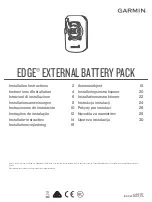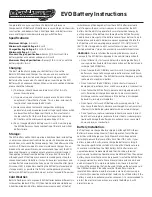
EXPORT IQ PLUS CHARGER (ONBOARD)
Test Procedures
Page 6-16
2008 Export Battery Charger Maintenance and Service Manual
6
5. Excessive heat due to a loose connection may also cause both fuse links to blow. Be sure fuse connec-
tions are tightened to 22 in-lb (2.5 N·m).
6. Ensure that the charger and vehicle are wired properly and all connections are clean and tight.
TEST PROCEDURE 5 – CHARGER DC CIRCUIT CONTINUITY TEST
See General Warning, Section 1, Page 1-1.
1. Disconnect the AC cord from the wall outlet.
2. Disconnect the batteries as instructed.
See General Warning, Section 1, Page 1-1.
3. Disconnect the charger DC cord at the three pin connector (8)
(Figure 6-23, Page 6-35)
.
4. Using a continuity tester (CCI P/N 1011273) or multimeter set to 200 ohms, connect the test probes to
the charger DC cord black wire and red wire terminals in the three pin connector. Note the reading.
5. Reverse the test probes and check the DC cord again. The circuit should show continuity in only one
direction.
6. If the circuit does not show continuity in either direction and the charger fuse is not blown, individually
check all connections and the continuity of the DC cord and ammeter.
See Test Procedure 8 – Conti-
nuity on page 6-18.
Also check the diodes (heatsink).
See Test Procedure 4 – Diodes on page 6-14.
7. If the circuit shows continuity in both directions, a short circuit exists in the charger DC circuit, usually
caused by failed diodes.
See Test Procedure 4 – Diodes on page 6-14.
If diodes have not failed, check
the DC cord for a short circuit.
See Test Procedure 8 – Continuity on page 6-18.
8. Check continuity between the DC cord red, black, and blue wires
(Figure 6-4, Page 6-6)
. There should
be no continuity.
TEST PROCEDURE 6 – TRANSFORMER
See General Warning, Section 1, Page 1-1.
Failure of the transformer may be caused by aging or a short circuit in adjacent coil turns. If the transformer
has failed, the ammeter will indicate low output or no output; however, the transformer may hum. A blown AC
line fuse or tripped AC circuit breaker in the charger or the storage facility may be caused by an improperly
wired charger, an improper setting of the AC voltage selector switch, or a failed transformer.
An AC circuit test should be done before performing this test procedure to ensure the continuity of the AC
cord, AC cord reel, internal AC circuit breakers, and charger wiring.
See Test Procedure 3 – AC Power and
Continuity Check of AC Circuit on page 6-13.
1. Disconnect AC cord from the wall outlet.
2. Remove the battery charger from the vehicle.
See Onboard Charger Removal on page 6-34.
3. Remove the charger cover.
4. Disconnect transformer secondary coil wires from the heatsink
(Figure 6-12, Page 6-17)
.
5. To apply AC power directly to the transformer primary coil, bypass the relay.
See Charging a Battery
Pack that has Low Voltage on page 6-31. See following DANGER.
ý
DANGER
• Do not touch any wire or component in the battery charger while AC power is present. Failure
to heed this warning will result in an electric shock.
















































